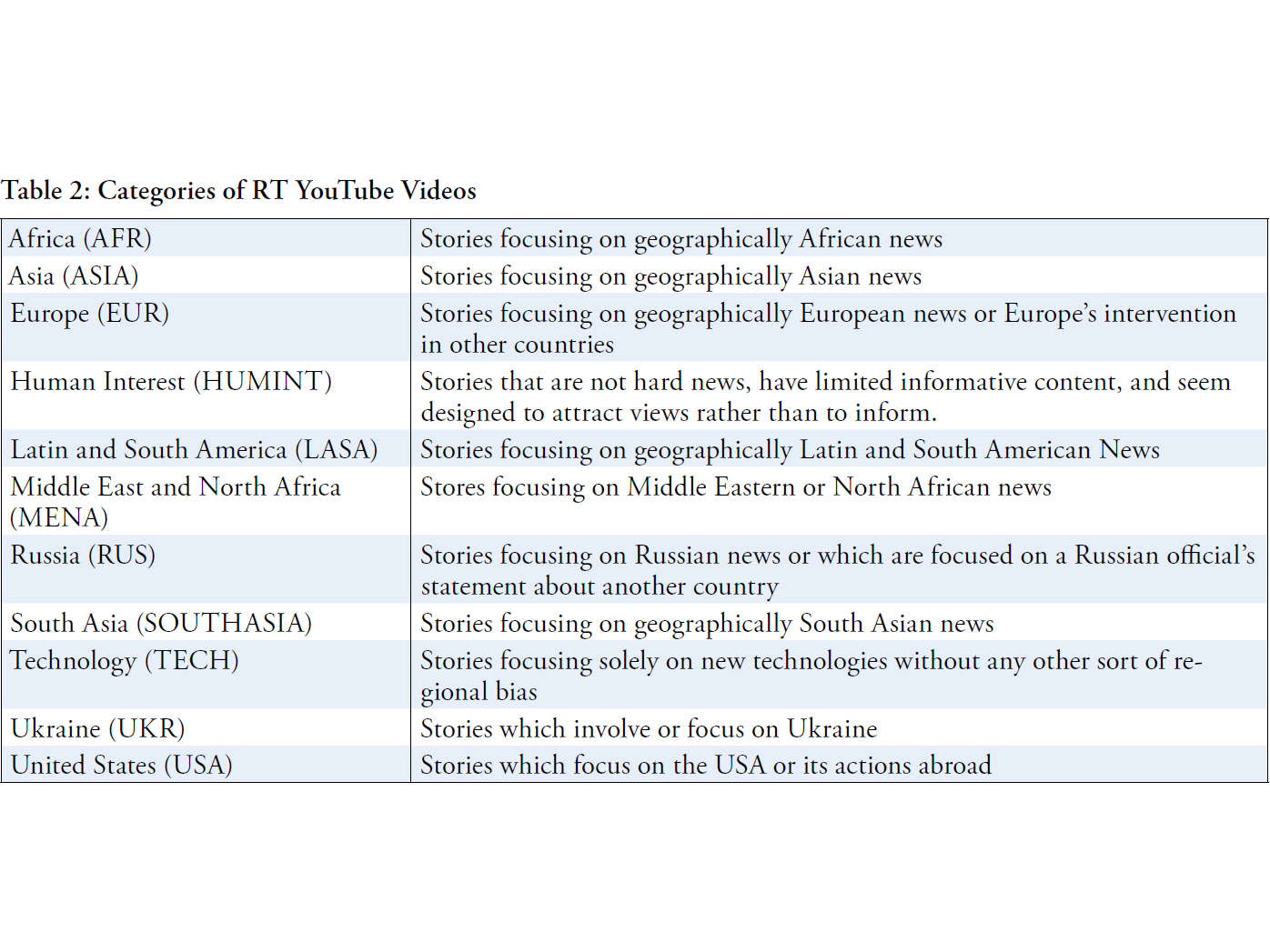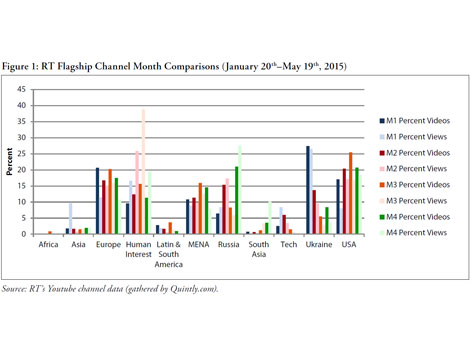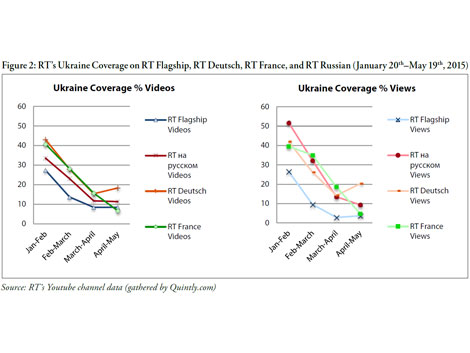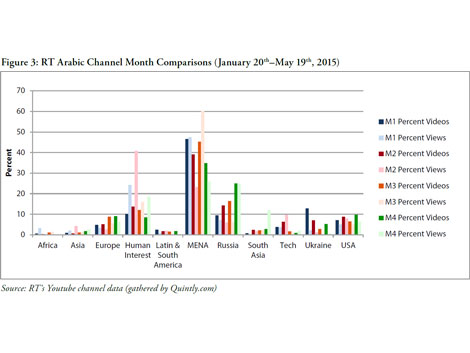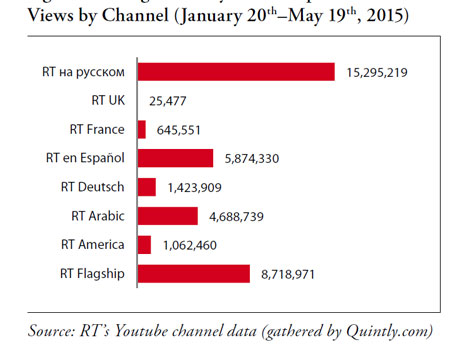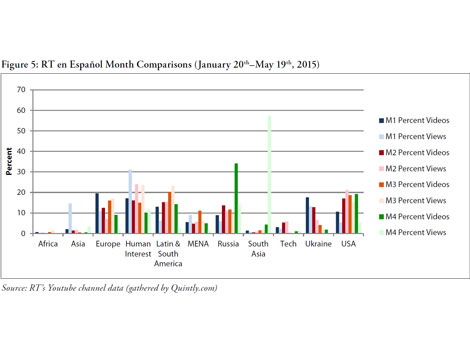Measuring RT’s Impact on YouTube
19 Jan 2016
By Robert Orttung, Elizabeth Nelson, Anthony Livshen for Center for Security Studies (CSS)
This analysis is featured in Issue 177 of the Russian Analytical Digest, which is published by the Center for Security Studies (CSS).
Abstract
In this paper, we explore Russia’s propaganda strategy through Russia Today (RT)’s YouTube programming. We develop a methodology by which we determine which topics RT focuses on for different audiences and its relative success in getting viewers on different channels. We also develop a hypothesis regarding RT’s larger strategy, with which RT seeks to target a different mix of news to different audiences, adapt its coverage to the broader international news cycle, promote a particular Kremlin-dictated ideology, and counter the West by attacking it across the same criteria by which Western countries criticize Russia.
Focused Messaging
Russian propaganda, specifically RT, is carefully targeted to different audiences and has nuanced messaging designed to undermine the West on the basis of its own criteria, build credibility by covering less-heard voices in regional news, and using human interest program (click-bait) to draw in viewers. This approach can be observed through a study of RT’s YouTube Channels, which is broken up into an English-language flagship channel (RT), RT America, RT Arabic, RT en Español, RT Deutsch, RT French, RT UK, and RT на русском. By separating audiences into linguistic categories, RT naturally separates out its priorities for each audience through its different ongoing messages in each channel.
Russia’s Propaganda Machine
Russia has developed a multi-platform, sophisticated propaganda machine in order to spread Kremlin messaging worldwide. This analysis focuses on RT because RT is the largest and most visible of these branches with both a large budget and multi-lingual reach on a variety of platforms. RT is also the easiest to track and provides the tools to create a ballpark estimate of efficiency, since YouTube videos provide a view count. RT has an annual budget of approximately $236 million dollars (though this figure has been continuously revised and not all funding is reported) and claims over 2 billion YouTube views, as well as nearly 1.5 million subscribers just on its main, English-language RT channel. In 2014, RT’s budget was $445 million based on a 30.5 ruble to 1 USD exchange rate and in September 2014, BBC reported that the government planned to raise RT’s budget by 40 percent. However, since then RT was forced to accept 10 percent less than in 2014. Additionally, about 80 percent of RT’s expenses are incurred abroad and the ruble’s value has plummeted, so Russian officials have said the news platform’s budget will be only $236 million in 2015. However, it appears that the Russian government still views RT as a valuable platform and plans to continue funding it, since RT debuted a new RT Chinese channel in May 2015.1
Additionally, as of June 10, RT has approximately 1,520,000 RT flagship channel subscribers, 255,000 RT America subscribers, 2,000 RT UK subscribers, 7,000 RT France subscribers, 392,000 RT en Español subscribers, 512,000 RT Russian subscribers, 31,000 RT Deutsch subscribers, and 304,000 RT Arabic subscribers. However, RT’s monthly viewership is even more impressive. According to our monthly data from the end of January 2015 through the end of May 2015, RT’s average monthly viewership as of May 20 is 8,718,971 for the flagship channel, 15,295,219 for the Russian-language channel, 5,874,330 for the RT Spanish-language channel, 4,688,739 for the RT Arabic channel, 1,423,909 for the RT German-language channel, 1,062,460 for RT America, 645,551 for RT France, and 25,477 for RT UK (See Table 1).
This data makes it clear that RT has gained a large following in its English-language flagship channel, a large Russian-speaking audience, a large Spanish-speaking audience, and a large Arabic-speaking audience. Its German-language and American channels are less popular, but still have over 1 million views per month. However, its French and UK channels are comparatively small, with 2,000–7,000 subscribers and under 1 million views per month.
RT often boasts about being the #1 news network on YouTube with a record 2 billion views, and according to RT itself, it is available to 700 million people in more than 100 countries in TV form as well. With this incredible reach and the highly biased nature of the news reporting produced by RT, it is no surprise that RT’s strategy and effective- ness have become critical questions in academic and foreign policy circles.
Data
This article analyzes data from RT’s YouTube channels from January 20 through May 19, collected in approximately one-month installments. This means that views are accumulated from the moment the video is posted that month to the time of collection, and that view figure is used in the monthly view count. This methodology was designed to capture a random set of videos in various parts of their lifecycle2 and to allow for a comparison to the effort proxy of the percent of videos uploaded pertaining to any given topic. While views per video per day could also be an interesting figure, there was not an intuitive comparison point for this in terms of the numbers of videos posted per month, since not all topics are covered every day. Our total dataset is currently 10,957 videos across all of RT’s YouTube channels. Each record collected consists of RT channel, video title, URL, and view count, which were gathered from YouTube by the social media tracking service Quintly. A total of 210 videos over four months were dropped because of broken video links which impeded categorization or because they could not fit adequately into any of the below delineated categories. The dropped videos were not concentrated in any particular channel and usually were either indecipherable in subject matter or single-personality news review shows that provided a survey of the previous week’s events.
Methodology
In order to track the subject matter of RT stories, we separated them into the categories listed in Table 2. The categories are mainly geographical, but we separated out human interest and technology videos that have no geographical focus.
Stories that cross geographical boundaries are difficult to categorize, but were generally categorized based on an idea of what motivated the coverage. For example, stories about South America that are a Russian official’s statement on South America are categorized as ‘Russia’ because that story would not be covered if it was any other country’s official speaking. In the case of Ukraine, anything involving Ukraine is sorted into the Ukrainian category, even if other actors are present.
The various channels of RT have different numbers of viewers and post different numbers of videos, so instead of looking at the absolute number of videos per month and the absolute number of views these videos received, we compared proportions. As such, the percentage of total videos posted per month in a particular category is used as a proxy for RT’s level of focus on that particular region or topic, and the proportion of views out of the total views in that channel in that month is used as a proxy for viewer interest in RT’s portrayal of that topic. For example (purely hypothetically), if RT’s Flagship channel is 40 percent Ukraine videos in from January to February, but only 10 percent of views that month were on Ukraine-related videos, we can see that RT’s Ukraine coverage is unsuccessful relative to the amount of content they are releasing on it.
Analysis and Discussion
RT has a sophisticated strategy for reaching its foreign audiences. First, RT targets a different mix of news to different audiences. Second, this targeting is not static, as RT’s coverage of events and topics moves with the popular news cycle. Third, even as RT tailors its reporting to individual audiences, it still retains an ideological bias that is particularly apparent in its coverage of the United States, Europe, and Ukraine. Finally, in terms of the content of its videos, RT tries to counter the West by attacking it across the same criteria by which Western countries criticize Russia: democracy, freedom, transparency, justice, and efficiency. The purpose of these reports is to undermine Western authority by raising doubts in the minds of audiences in regions across the globe of the West’s ability to live up to its own values. RT also uses human interest stories without ideological content to attract viewers to its channels.
The effectiveness of RT’s strategy differs across its many channels and through geographic regions. On some channels, the mix of coverage is effective at eliciting corresponding viewership, while other channels are unable to attract a substantial number of viewers or focus them on the Kremlin’s chosen messages.
The distribution of videos in the RT Flagship Channel in Figure 1 shows how RT adjusts its priorities based on the current news cycle. The chart shows the month-by-month proportion of RT videos posted in each category and the views of those videos as a percentage of total views on the channel that month. In each cluster the first bar (in dark colors) is the proportion of videos, while the subsequent bar (in light colors) is the proportion of views for those videos.
While the proportion of many topics remain the same across the four months, attention to Ukraine declined over time, while the focus on Russia simultaneously increased. As Ukraine started to be a less popular topic, RT adjusted down its Ukraine coverage and ramped up its Russia coverage to take advantage of the opportunity of positive coverage of Russia for the 70th anniversary of World War II. A similar adjustment is visible in other channels. Figure 2 overleaf shows how the percentage of videos devoted to Ukraine and percentage of total views corresponding with Ukraine-focused videos has decreased, as might be predicted with RT following the popular news cycle.
RT’s flagship channel is also a good place to observe its success in using human interest stories to draw views, how- ever both RT Arabic and RT Spanish show this element of RT’s strategy with greater emphasis.
RT Arabic is another example of a channel that uses human interest programming to draw in viewers. RT Arabic is also a clear example of how RT focuses on regional news on some channels to build credibility. In order to get viewers to believe their extremely biased coverage of issues like Ukraine, RT must build credibility and provide a legitimate “second opinion,” at least some of the time. Accordingly, the vast majority of the coverage in the RT Arabic channel is devoted to Middle East issues. Most of this coverage is aimed at issues of heightened importance in the region, such as ISIS (of which coverage remains relatively devoid of Kremlin ideology), but other issues such as Syria, Yemen, and Israel/Palestine receive more ideologically salient coverage. RT seems to lean more pro-Palestinian, but this seems likely to be more an anti-U.S. reaction than a Middle East policy. RT takes a decidedly pro-Assad stance on Syria, as might be expected considering Russia’s foreign policy. RT therefore reports Assad’s comments on the West and on Russia’s importance in the Middle East. RT has also posted many stories criticizing the Saudi Arabian campaign in Yemen.
In Figure 3 it is evident that RT’s Middle East and North Africa coverage makes up between 35–45 percent of videos posted in a given month, and constitutes somewhere between 23–60 percent of all channel views per month. Human Interest composes a comparatively small proportion of videos, somewhere between 8–10 percent of videos, but in some months, it has consisted of more than 20 percent and up to 40 percent of total channel views. The percent of videos and viewers on other topics and regions remains otherwise relatively unremarkable, except for consistently under- watched Russia coverage. In the final month, viewership of videos addressing Russian topics was substantially higher than the others, but this is largely due to a spike in World War II retrospective coverage and above all, broadcasts of Russian military parades commemorating World War II. South Asian news viewership spiked in the last month pre- dominantly due to coverage of the Nepal earthquakes. RT Arabic is particularly emblematic of RT’s strategy of building credibility through coverage of local news and human interest stories, but also reflects the difficulties Russia has had in adapting its Ukraine message. RT did not even try to push its Ukraine coverage on the RT Arabic channel and viewership of Ukraine-related coverage was minimal. Another element of RT’s strategy is its coverage of events in the West, both in terms of its selection of what stories to report and how to cover them. RT seeks to undermine Europe and the United States based on the same criteria by which the West criticizes Russia. Since democracy, freedom, transparency, justice, and efficiency are all critical parts of the Western narrative, RT chooses stories to cover that criticize various countries on their inability to live up to strong levels of support for these basic values. It therefore makes sense that RT heavily covers protests about European Central Bank policies, American and European police violence, racial tensions in the USA, immigration problems in Europe, and far-right parties such as Syriza and Podemos. It emphasizes European disunity, especially in regards to financial matters and political conflicts between Germany, on one side, and Spain and Greece, on the other. RT also emphasizes electoral problems in the United Kingdom and Greece and protests against police violence in the United States. RT’s news on these topics involving Europe, the U.S., and Ukraine carries a very distinctive angle, visible even in just the titles of the videos uploaded. For example, on January 22 and 23, the videos uploaded to the RT Flagship channel about Europe included: “Peter Schiff on ECB ‘easy money’—‘Things are going to get worse’”, “Zombie banks & lame duck businesses”, “Election Fever: Greeks ‘desperate’, Syriza strides ahead, Brussels nervous”, “Celente: We live in bankism, not capitalism, ECB QE is massive fraud” and “CrossTalk on Greece: Electoral Farce?”
In addition to reporting from a biased angle on topics of Russian foreign policy concern, RT also reports on some topics less covered by other media organizations but which fit Russia’s foreign policy goals. For example, RT reports unusually heavily on Venezuela and conducts many interviews with prominent Spanish-speaking authors and politicians on their RT en Español channel and was nominated for an International Emmy for its coverage of Occupy Wall Street for their American coverage.
As demonstrated above, RT shifts the distribution of topics it conveys to different audiences, including using human interest stories to draw in audiences and covering topics and view points not covered by other popular media options. RT also shifts its coverage according to the news cycle, reflecting RT’s need to maintain legitimacy as a “second opinion” and alternative to conventional Western news media. However, even as it tailors and shifts its coverage, RT also maintains its Kremlin-dictated ideological lens. This is particularly evident in its coverage of the West and Ukraine, in which it utilizes a strategy of attacking Western countries based on the criteria they themselves pro- mote. The relative effectiveness of different elements of this strategy is difficult to uncover, but we explore insights drawn from comparing viewership across categories in the ensuing section and in looking at the level of viewership each channel has managed to attract.
Effectiveness
RT’s ability to connect with its audience varies by region. As is clearly visible, RT France and UK have smaller audiences, which is also reflected in the quantities of videos posted. RT America is also relatively small, but the channel focuses solely on U.S.-based news and leaves the international news to the English-language RT Flagship channel. RT Flagship, RT Arabic, RT en Español, and RT Russian have substantial viewing populations. As was discussed earlier, this is also evident in the channels’ distribution of subscribers. Differential channel success, however, is less nuanced than the content and viewer distribution.
Figure 4 overleaf shows RT has had widely varied success across its channels. It is most successful with Russian- speaking populations, averaging around 15 million viewers per month. RT’s Spanish-language and Arabic-language channels are also quite popular, with nearly 6 million views and around 4.5 million views per month respectively. RT’s English-language coverage is only popular to the extent that viewers watch the RT Flagship channel, which receives around 9 million views per month and is RT’s most internationally-aimed channel. Otherwise, RT’s distinctly American aimed channel has low viewership numbers at only a million viewers per month. RT’s audiences in the UK, France, and to a lesser extent Germany, have remained small. As the RT en Español channel distribution shows (Figure 5 below), on some channels RT’s most successful programming remains its human interest programming driven more by shock value than ideology. The bump in South Asia coverage primarily concerns the Nepalese earthquakes, which were widely watched by RT en Español viewers. It likely took away views from that month’s human interest programming, because RT tends to include a certain amount of “destruction” videos in its human interest programming, either of demolishing buildings or pictures of disasters. These results indicate that RT’s strategy of attracting viewership through human interest programming is working. Similarly, RT Arabic’s human interest programming has also been quite successful. RT Arabic’s regional news coverage has had less consistent success, but at times has succeeded in drawing in viewers. In contrast, RT’s Ukraine programming has never been a large component of their Spanish-language channel or Arabic-language channel and remained under-watched in both, even at a time when Ukraine was one of the top topics of world news. The small proportion of videos devoted to covering Ukraine and the even smaller corresponding percentage of views show that in the regions where RT has the most viewers (excluding RT Russian) RT’s Ukraine coverage has failed to take root.
However, in the RT France (Figure 6) and RT Deutsch (Figure 7) channels, Ukraine has been at times the dominant subject of both videos and viewership. At the start of the sample in late January, both channels had over 40 percent of videos focused on Ukraine, and over 40 percent of viewership corresponded with Ukraine coverage. Though coverage dropped off significantly, corresponding with normal news cycles, Ukraine still remains a prominent topic on the RT Deutsch channel with 20 percent of viewership. Russia-related coverage has also been high at times in both channels. The dual focus on Russia and Ukraine, in addition to standard European news, shows how RT has prioritized its Russia and Ukraine related messages for German and French-speaking populations. Furthermore, the viewership proportions indicate that audiences have been receptive to RT’s coverage. This is consistent with Russian foreign policy and efforts to polarize and divide European public opinion, and thus European governments. However, since the European individualized channels serve smaller populations and demographic information is unknown, it may be that RT is polarizing existing populations within these countries or new audiences might be finding their coverage appealing.
Conclusion
After categorizing RT’s YouTube news coverage for four months, we observe that RT is pursuing a dedicated messaging agenda targeted towards individual populations in different linguistic groups. While it may cause confusion in target populations regarding the factual truth, it does this partly by covering some events with relative objectivity, while distorting other stories on topics where it has a definite ideological bent. RT’s coverage mix changes dramatically between regions, showing sensitivity to regional interests, even though RT is not always able to adapt its key messages, such as the Kremlin-backed line on Ukraine, in different countries or linguistic groups. Furthermore, RT’s coverage follows a rough plan based on Western values, based on which the U.S. and Europe criticize Russia. By propagating negative coverage of the West based on the very values Western powers themselves use, RT attempts to undermine Western credibility and unity.
It remains difficult to assess, however, whether or not RT’s anti-Western messaging is actually having an effect. Previous studies have looked at the effect of biased news on political views when populations already have strong opinions on the subject and know the origins of the news source. It is unclear, however, if a similar polarization would occur when viewers are not aware of the ideological backing of the news source, and if they do not hold previous strong views. Further efforts to more concretely measure viewer attitude change are therefore essential to understanding the impact of RT’s news coverage. Though we have examined RT’s channel-dependent strategy and corresponding success in gaining viewership, it remains to be seen what the effect actually is on viewers once they watch RT’s coverage of events.
Footnotes
1. Unfortunately this new channel was introduced too late to incorporate into our data, but it provides evidence that the Russian government views RT as successful enough to continue funding and even expand the program, despite economic hardship.
2. Videos generally experience rapid initial growth in views when they are posted and then level off. This can be seen on an individual video basis in the YouTube interface.


